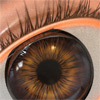- Fri Jul 01, 2005 7:32 pm
#41819
Hallo,
I have download Thomas file and tryed to render a colored glass. After some problems, I have simplified the scene - a sphere emitter and the glass in the middle. The glass (abs 0.99, abbe 200, ND1.51, RGB 180-220-136) is splitted and the liquid (abs 0, abbe 200, ND 1.33, RGB 251-242-211) is one colosed object.
Problems:
- a big black area in the bottom of the glass
- the lower glass part with liquid looks brighter than the upper part with air (seems to be an absorbtion problem)
- the foot of the glass looks so bright (to less absorbtion)
Edit:
- if I use a strong absorbtion, is it the bright wall on the side in the upper part of the glass in the second image normal?
C&C are wellcome.

I have download Thomas file and tryed to render a colored glass. After some problems, I have simplified the scene - a sphere emitter and the glass in the middle. The glass (abs 0.99, abbe 200, ND1.51, RGB 180-220-136) is splitted and the liquid (abs 0, abbe 200, ND 1.33, RGB 251-242-211) is one colosed object.
Problems:
- a big black area in the bottom of the glass
- the lower glass part with liquid looks brighter than the upper part with air (seems to be an absorbtion problem)
- the foot of the glass looks so bright (to less absorbtion)
Edit:
- if I use a strong absorbtion, is it the bright wall on the side in the upper part of the glass in the second image normal?
C&C are wellcome.

Last edited by Micha on Sat Jul 02, 2005 2:22 pm, edited 2 times in total.
Rhino3D and more - 3D visualisation for designers and architects ... my gallery ... Freelance. ... www.simulacrum.de








 - By Mark Bell
- By Mark Bell - By Edward Leibnitz
- By Edward Leibnitz